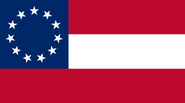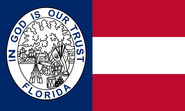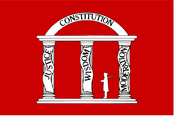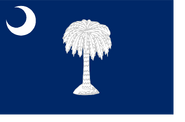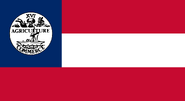The flags of the Confederate States of America have a history of three successive designs during the American Civil War. The flags were known as the "Stars and Bars", used from 1861 to 1863; the "Stainless Banner", used from 1863 to 1865; and the "Blood-Stained Banner", used in 1865 shortly before the Confederacy's dissolution. A rejected national flag design was also used as a battle flag by the Confederate Army and featured in the "Stainless Banner" and "Blood-Stained Banner" designs. Although this design was never a national flag, it is the most commonly recognized symbol of the Confederacy.
Since the end of the Civil War, private and official use of the Confederate flags, particularly the battle flag, has continued amid philosophical, political, cultural, and racial controversy in the United States. These include flags displayed in states; cities, towns and counties; schools, colleges and universities; private organizations and associations; and individuals. The battle flag was also featured in the state flags of Georgia and Mississippi, although it was removed by the former in 2003 and the latter in 2020. After the former was changed in 2001, the city of Trenton, Georgia has used a flag design nearly identical to the previous version with the battle flag.
History[]
The first official national flag of the Confederacy, often called the "Stars and Bars", was flown from March 4, 1861, to May 1, 1863. It was designed by German/Prussian artist Nicola Marschall in Marion, Alabama, and resembled the flag of the Austrian Empire (later Austria-Hungary, now the Republic of Austria), with which Marschall would have been familiar. The "Stars and Bars" flag was adopted March 4, 1861, in the first temporary national capital of Montgomery, Alabama, and raised over the dome of that first Confederate capitol. Marschall also designed the Confederate army uniform.
On the 1st of May, 1863 the Confederate House of Representatives met to discuss the creation of a new national flag as part of Senate Bill No.132, the original proposed flag was one which the Army of Northern Virginia Battle Flag in the canton, and with the "Bars" from the "Stars and Bars" in white, dark blue and white. This flag was replaced by a motion with a flag which featured the Battle Flag on the white field with a red border, Congressman Ethelbert Barksdale of Mississippi made a motion to remove the stars from this flag, stating "the flags of the two nations should be as distinct as the characters of the two peoples.", however his motion was defeated, and the stars stayed.
Gallery[]
1st Flag: Stars and Bars (1861-1863)[]
The Stars and Bars was the first flag of the Confederate States of America. It was designed by Nicola Marschall in Marion, Alabama, and is said to resemble that of Austria's. The flag is a horizontal triband of red and white, and in the top left corner, there is a blue square with 13 stars in a circular pattern. The number of stars changed periodically from 7 to 13. In 1863, the Stars and Bars was scrapped for the Stainless Banner, as the former would get confused for the flag of the Union when it hung limp and seen far away.
2nd Flag: The Stainless Banner (1863-1865)[]

The Stainless Banner.
Many different designs were proposed during the solicitation for a second Confederate national flag, nearly all based on the Battle Flag. By 1863, it had become well-known and popular among those living in the Confederacy. The Confederate Congress specified that the new design be a white field "...with the union (now used as the battle flag) to be a square of two-thirds the width of the flag, having the ground red; thereupon a broad saltire of blue, bordered with white, and emblazoned with mullets or five-pointed stars, corresponding in number to that of the Confederate States."
The flag was known as the Stainless Banner, and the matter of the person behind its design remains a point of contention.
The flag was white with the Confederate battle flag in the top left corner. White symbolised how white people were "superior" and black people were "inferior".
The flag was scrapped in 1865 for the Blood-Stained Banner because the flag was difficult to keep clean, plus it could be easily mistaken for a sign of surrender.
3rd and final flag: The Blood-Stained Banner (1865)[]
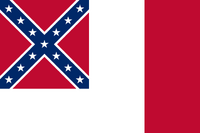
The last flag of the Confederate States of America before its dissolution.
Rogers lobbied successfully to have this alteration introduced in the Confederate Senate. Rogers defended his redesign as symbolizing the primary origins of the people of the Confederacy, with the saltire of the Scottish flag and the red bar from the flag of France, and having "as little as possible of the Yankee blue" — the Union Army wore blue, the Confederates gray. The Flag Act of 1865, passed by the Confederate congress near the very end of the War, describes the flag in the following language:
The Congress of the Confederate States of America do enact, That the flag of the Confederate States shall be as follows: The width two-thirds of its length, with the union (now used as the battle flag) to be in width three-fifths of the width of the flag, and so proportioned as to leave the length of the field on the side of the union twice the width of the field below it; to have the ground red and a broad blue saltire thereon, bordered with white and emblazoned with mullets or five pointed stars, corresponding in number to that of the Confederate States; the field to be white, except the outer half from the union to be a red bar extending the width of the flag.
Due to the timing, very few of these third national flags were actually manufactured and put into use in the field, with many Confederates never seeing the flag. Moreover, the ones made by the Richmond Clothing Depot used the square canton of the second national flag rather than the slightly rectangular one that was specified by the law.
State flags[]
Indian Territory[]
Add photos here
Battle flag[]
At the First Battle of Manassas, near Manassas, Virginia, the similarity between the "Stars and Bars" and the "Stars and Stripes" caused confusion and military problems. Regiments carried flags to help commanders observe and assess battles in the warfare of the era. At a distance, the two national flags were hard to tell apart. Also, Confederate regiments carried many other flags, which added to the possibility of confusion.
The battle flag is a red square with a blue saltire bordered white. In the saltire, there are 13 white mullets, or five pointed stars. The mullets are for each state. Despite the Confederacy only having 11 states, 2 US states are recognised by the Confederacy.
A similar naval flag existed, but with a wider field and lighter shade of blue.
Controversy[]
Further information: https://en.wikipedia.org/wiki/Modern_display_of_the_Confederate_battle_flag
Though never having historically represented the Confederate States of America as a country, nor having been officially recognized as one if its national flags, the battle flag of the Army of Northern Virginia and its variants are now commonly referred to as the Confederate Flag. This design has become commonly associated with racism, white supremacy, or white nationalism, especially in the southern United States. Due to many extremist groups adopting this flag, many places and websites don't permit displays or sales of it.










